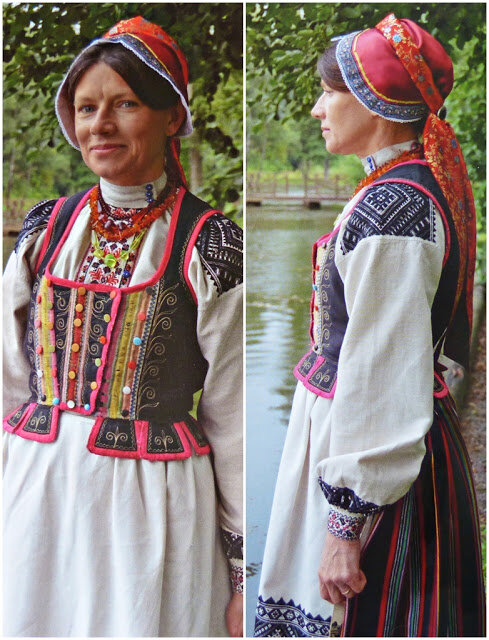Belarusian Traditional Clothing and A Contemporary Artist Embroidering in Protest
Left: Festive costume of a girl, Luki village, Homel region, Eastern Palesse via local-moda.blogspot.com and art by Rufina Bazlova via Instagram (cropped).
I recently gave a private lecture on the traditional clothing and embroidery of Belarus to an American woman and her mother. While researching the topic, I was delighted to discover the work of a young Belarusian artist, Prague-based Rufina Bazlova, using embroidery to support the protests that erupted in August. Embroidery has always served as a means of communication. It's exciting to see art that uses stitching, folk culture, and representations of national identity to make a statement against corruption.
Demonstrations in Belarus began last spring, leading up to the presidential election. Candidate Sergei Tikhanovsky nicknamed the protests the "Anti-Cockroach Revolution," referring to president Alexander Lukashenko as the cockroach, after the children's poem about a dictatorial yet fragile roach that terrorizes the other animals and is eaten by a sparrow. Look for the cockroach in Bazlova’s work.
Rufina Bazlova, Brutality in "Okrestino", 2020.
Rufina Bazlova, Detail of Solidarity with Soligorsk, Put Salt on the Wound, 2020.
Rufina Bazlova, ŽENOKOL // FEMINNATURE, 2012
part I. Embroidered comic for a dress, fictional story of how the Amazons could’ve been born via @rufinabazlova on Instagram. The figures resemble historical Belarusian cross stitch symbols.
In August, president Lukashenko claimed victory, granting him another five-year term and making this his sixth term in office since his election in 1994. His main opponent, Svetlana Tikhanovsky, who ran in place of her husband Sergei after he was arrested in May, declared the results fraudulent. In September Lukashenko was declared president in a private ceremony. The European Union then published a statement against Lukashenko calling for new elections and condemning the violence. The EU later imposed sanctions against 40 Belarusian officials. At the end of 2020, human rights organizations recorded over 1000 accounts of torture experienced by protesters.
Protests continue, and authorities continue to detain, beat, fine, and imprison journalists. Lukashenko remains in office, now making plans to pass power to his son if he dies (as of an article dated Apr. 24, 2021). For the current news, read here.
Back to the embroidery! Most regions used counted thread work on their blouses with decorative stitching on headscarves, vests, and aprons. Here are some images of the traditional dress from the 17 - 1900s from different areas. There are six ethnographic regions in Belarus, each with variations in styles and motifs. Notice similarities with Polish and Russian dress due to shared borders and periods of rulership.
Festive costumes, Kalinkavichy district, Homel region, Eastern Palesse
Festive costume of a married woman, Malaryta district, Brest region, Western Palesse
1911-12, from the collection of Isak Serbov, location unknown.
Colorful ribbons and embroidery embellish the clothing from parts of Eastern and Western Palesse in the Brest region in the south. A bit of free embroidery decorates the vest.
Festive costume of a married woman with a headdress kaptur, Brest district, Brest region, Western Palesse via local-moda.blogspot.com
Festive dresses of a girl and a young man, Brest district, Brest region, Western Palesse
The Dniapro region borders Russia to the east and Ukraine to the south.
Festive costume of a married woman, Dobrush district, Homel region, the Dniapro area
Clothing from the Nioman area, now the Grodno region, share Polish and Lithuanian borders and influences.
Festive costume of a young woman, Nioman area (left) and festive costume of a young woman, Maladzechna district, Minsk region, Nioman area
Do you know more about Belarusian clothing and embroidery? Please email me to share information!
Sources:
local-moda.blogspot.com
www.perunica.ru
survincity.com/2011/01/specialist-most-elements-of-national-belarusian
hrw.org
aljazeera.com
en.wikipedia.org











